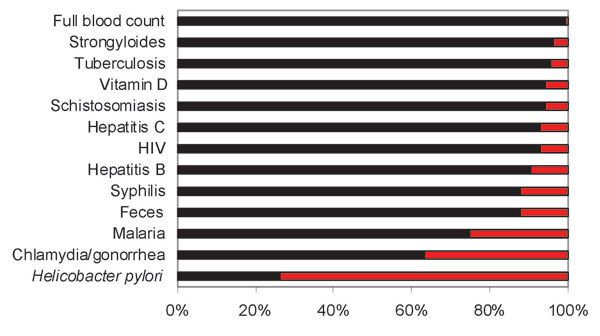Volume 15, Number 11—November 2009
Research
Screening Practices for Infectious Diseases among Burmese Refugees in Australia
Figure

Figure. Proportion of 156 recently arrived Burmese refugees with documented screening tests for common health conditions, Australia, 2004–2008. Most of these tests are recommended by the Australasian Infectious Diseases Society guidelines (5). Tests for vitamin D levels are beyond the scope of these guidelines. Black, tested; red, not tested.
References
- Australian Government Department of Immigration and Citizenship. Fact sheet 60—Australia’s refugee and humanitarian program. 2008 [cited 2009 May 11]. Available from http://www.immi.gov.au/media/fact-sheets/60refugee.htm
- United States Department of Health and Human Services, Office of Refugee Resettlement. Fiscal year 2007 refugee arrivals. 2008 [cited 2009 March 30]. Available from http://www.acf.hhs.gov/programs/orr/data/fy2007RA.htm
- Australian Government Department of Immigration and Citizenship. Fact Sheet 67a—Pre-departure medical screening. 2008 [cited 2009 Feb 16]. Available from http://www.immi.gov.au/media/fact-sheets/67a_pdms.htm
- Foundation House—The Victorian Foundation for Survivors of Torture. Promoting refugee health—a guide for doctors and other health care providers caring for people from refugee backgrounds. 2007 [cited 2009 Mar 26]. Available from http://www.foundationhouse.org.au/resources/publications_and_resources.htm
- Australasian Society for Infectious Diseases. Diagnosis, management and prevention of infections in recently arrived refugees. Sydney (NSW, Australia): Dreamweaver Publishing Pty Ltd.; 2008 [cited 2009 Mar 26]. Available from http://www.asid.net.au/downloads/RefugeeGuidelines.pdf
- Denburg A, Rashid M, Brophy J, Curtis T, Malloy P, Audley J, Initial health screening results for Karen refugees: a retrospective review. Can Commun Dis Rep. 2007;33:16–22.PubMedGoogle Scholar
- Chute S. Karen refugees from Burma. 2007 [cited 2009 Feb 16]. Available from http://www.health.state.mn.us/divs/idepc/refugee/metrotf/karenarrival.pdf
- Nuchprayoon S, Sandprasery V, Kaewzaithim S, Saksirisampant W. Screening for intestinal parasitic infections among Myanmar migrant workers in the Thai food industry: a high risk transmission. J Immigr Minor Health. 2009;11:115–21. DOIPubMedGoogle Scholar
- Piangjai S, Sukontason K, Sukontason K. Intestinal parasitic infections in hill-tribe schoolchildren in Chiang Mai, Northern Thailand. Southeast Asian J Trop Med Public Health. 2003;34(Suppl 2):90–3.PubMedGoogle Scholar
- Saksirisampant W, Prownebon J, Kanmarnee M, Thaisom S, Yenthakam S, Nuchprayoon S. Prevalence of parasitism among students of the Karen Hill Tribe in Chame District, Chiang Mai Province, Thailand. J Med Assoc Thai. 2004;87(Suppl2):S278–83.PubMedGoogle Scholar
- Einsiedel L, Spelman D. Strongyloides stercoralis: risks posed to immigrant patients in an Australian tertiary referral centre. Intern Med J. 2006;36:632–7. DOIPubMedGoogle Scholar
- Cherian S, Forbes D, Sanfilippo F. The epidemiology of H. pylori infection in African refugee children. Med J Aust. 2008;189:438–44.PubMedGoogle Scholar
- Gibney K, Mihrshahi S, Torresi J, Marshall C, Leder K, Biggs BA. The profile of health problems in African immigrants attending an infectious diseases unit in Melbourne, Australia. Am J Trop Med Hyg. 2009;80:805–11.PubMedGoogle Scholar
- Muhsen K, Cohen D. Helicobacter pylori infection and iron stores: a systematic review and meta-analysis. Helicobacter. 2008;13:323–40. DOIPubMedGoogle Scholar
- Suerbaum S, Michetti P. Medical progress: Helicobacter pylori infection. N Engl J Med. 2002;347:1175–86. DOIPubMedGoogle Scholar
Page created: December 09, 2010
Page updated: December 09, 2010
Page reviewed: December 09, 2010
The conclusions, findings, and opinions expressed by authors contributing to this journal do not necessarily reflect the official position of the U.S. Department of Health and Human Services, the Public Health Service, the Centers for Disease Control and Prevention, or the authors' affiliated institutions. Use of trade names is for identification only and does not imply endorsement by any of the groups named above.